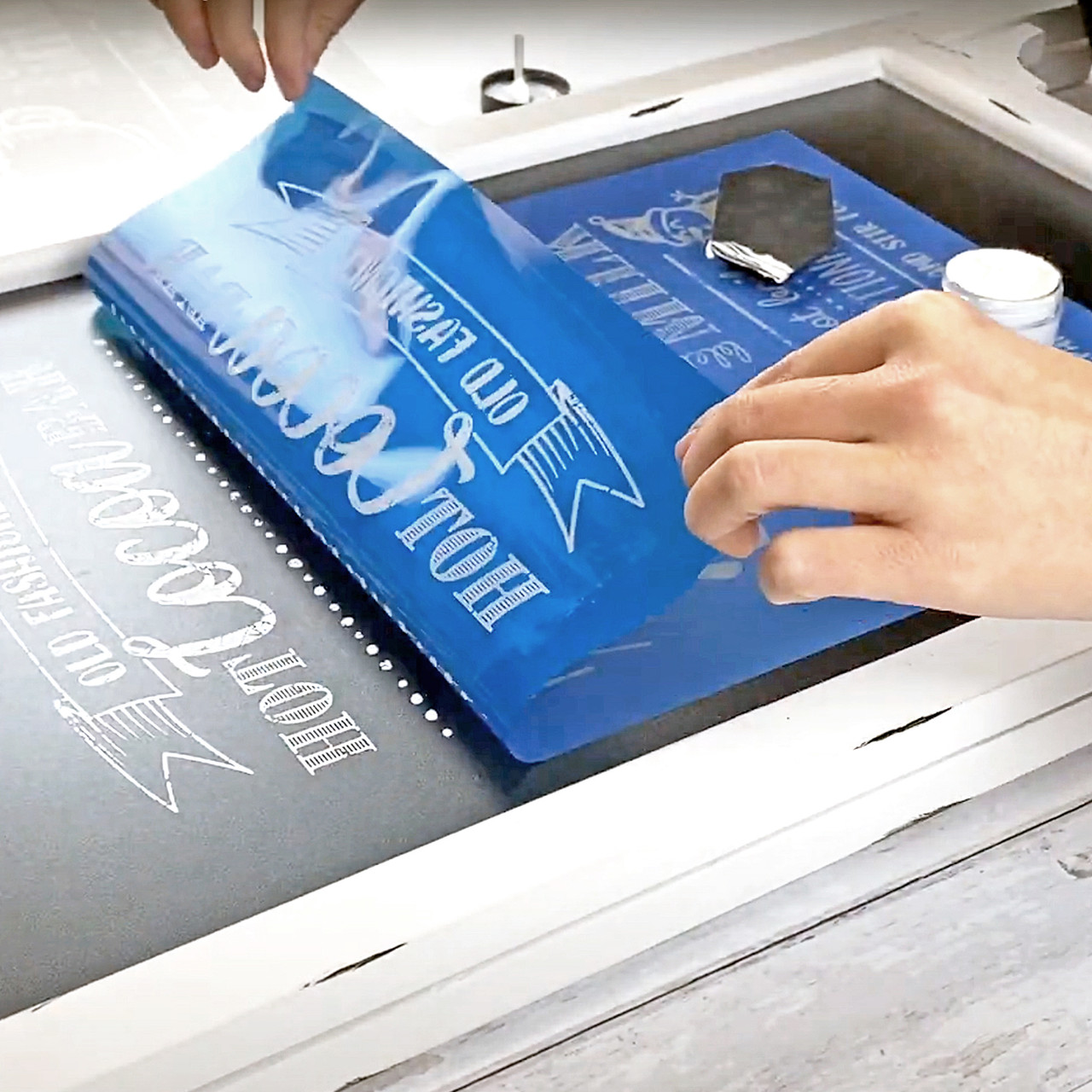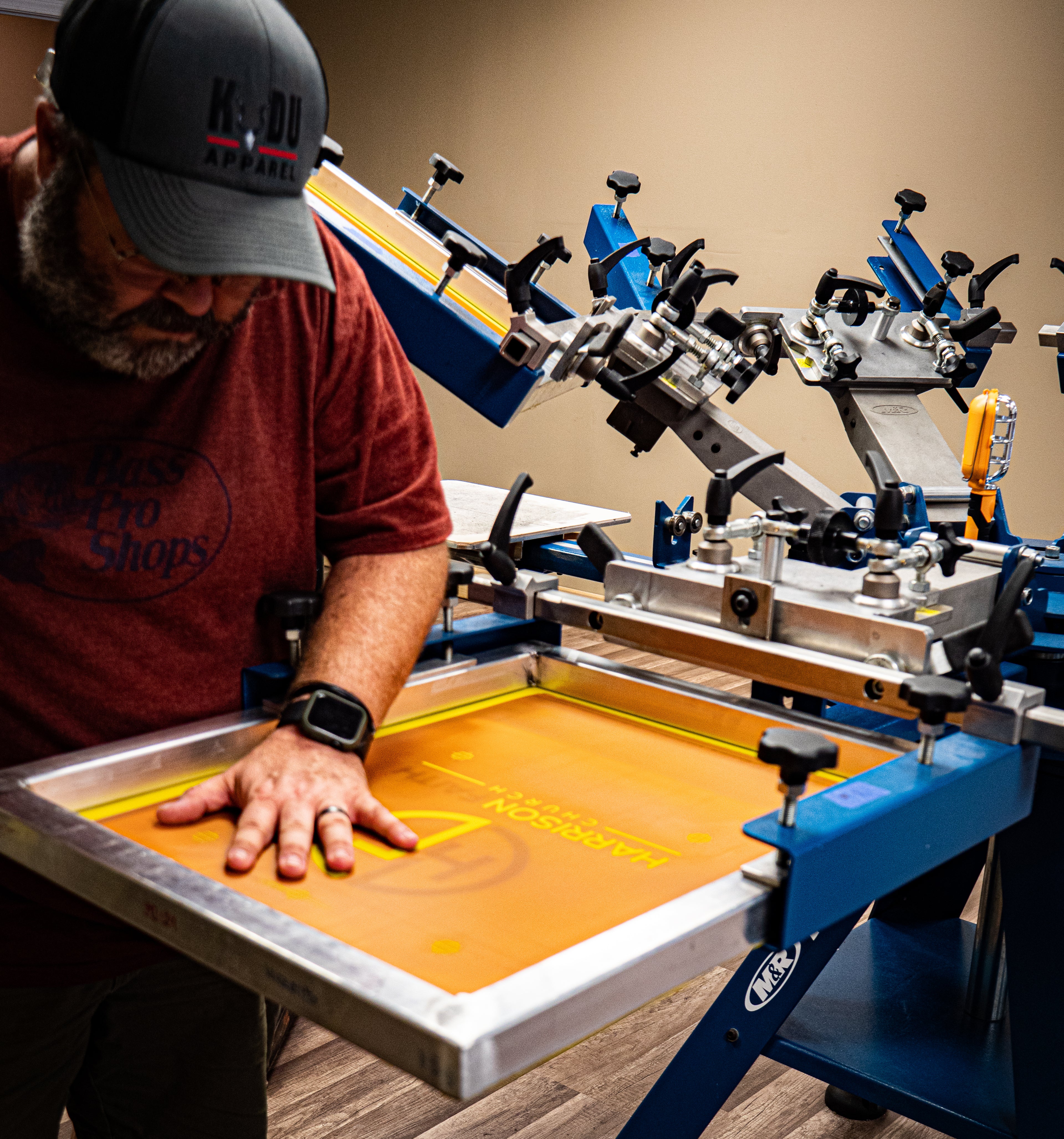Custom Screen Printing for Unique Promotional Merchandise
Custom Screen Printing for Unique Promotional Merchandise
Blog Article
Screen Printing Uncovered: Everything You Required to Know Concerning Tee and Garment Printing Techniques
Display printing is an interesting approach that combines art with strategy, providing unlimited possibilities for imagination. Ready to discover the essential components that make display printing an art form?
The Fundamentals of Screen Printing: Just How It Functions
When you dive into screen printing, you'll discover it's both an art and a science. At its core, display printing involves creating a pattern, or screen, that allows ink to go through just in certain locations (screen printing kit). You start by choosing your layout and preparing your display with a light-sensitive emulsion. Once you reveal this solution to light, it solidifies, leaving your layout as an unfavorable room.
Next, you'll blend your inks and prepare your printing surface. Placement the screen over the material, then utilize a squeegee to push ink via the screen onto the garment. This procedure requires accuracy, as you want clear, vibrant prints. After printing, you'll treat the ink with warmth, ensuring it abides by the fabric and lasts via washes. Each action is important, and understanding them will boost your screen printing skills, transforming straightforward garments into one-of-a-kind, expressive items.
Sorts Of Screen Printing Techniques
As soon as you comprehend the fundamentals of display printing, it's time to explore the different strategies that can raise your designs. One prominent method is typical screen printing, where ink is pressed via a stenciled display. This strategy is wonderful for bold, dynamic colors. Then there's water-based ink printing, which uses a softer feeling and is environmentally friendly, however it calls for a various strategy to healing.
An additional alternative is plastisol printing, known for its durability and vibrant colors, making it a favored for lots of brands. Experiment with halftone printing to develop gradient results and elaborate layouts.
Crucial Devices for Screen Printing
To attain sensational cause display printing, having the appropriate devices is essential. First, you'll need a sturdy display printing structure, which holds the mesh that transfers your style onto the garment. Next off, invest in top notch squeegees; these are necessary for using ink evenly across the display. You'll also require a great direct exposure unit to produce your displays, in addition to a washout booth for cleansing them after use. A trusted warmth source, like a conveyor dryer or warm press, is critical for curing your prints to assure longevity. Don't neglect a proper work area, furnished with tables and storage space for your supplies. Safety gear, such as gloves and masks, will keep you safe from chemicals and inks. With the right tools, you'll be well on your way to creating professional-quality prints.
Picking the Right Inks and Materials
When choosing inks and materials for screen printing, you need to take into account the sort of ink that functions ideal for your task. Think of textile compatibility to assure your designs look last and great long. Explore green ink options to make your printing process a lot more lasting.
Kinds Of Screen Inks
Picking the best display ink is important for accomplishing vibrant, long lasting prints that satisfy your job's demands. There are a number of types of display inks to take a look at. Plastisol ink is prominent for its versatility and convenience of use, giving exceptional shade opacity on dark textiles. Water-based ink, on the other hand, offers a softer feeling and is environment-friendly, making it suitable for those seeking to reduce their ecological effect. Discharge inks get rid of color from the fabric, causing a soft, vintage appearance yet need specific handling. Lastly, specialty inks, such as metal or glow-in-the-dark, can include unique results to your designs. Assess your task demands and pick the ink that aligns finest with your desired outcome.

Fabric Compatibility Considerations
Recognizing material compatibility is important for accomplishing high-grade display prints, especially considering that various materials react distinctively to numerous inks. Constantly check your inks on sample material to assure they stick effectively and maintain color stability. Furthermore, keep in mind that material weight and texture can impact the final outcome, so selecting the best ink and material combination is essential for your job's success.
Eco-Friendly Ink Options
Green inks are coming to be a preferred selection for display printers who wish to lessen their ecological effect while preserving high quality. When picking inks, consider water-based inks, which are much less harmful and less complicated to tidy up compared to typical solvents. These inks bond well with fabrics, providing lively outcomes without toxic chemicals. You may likewise discover eco-solvent inks that make use of fewer unstable organic substances (VOCs), making them a safer choice for both your wellness and the planet.
Additionally, search for inks made from sustainable sources, such as soy or vegetable-based alternatives. By choosing the best inks and materials, you'll not only produce sensational styles but also add to a more sustainable printing process. Make the switch, and your prints will show your dedication to the setting!
Preparing Your Design for Display Printing

File Layout Demands
To ensure your layout looks sharp and vibrant on material, you'll need to pay attention to file style requirements for display printing. Start with vector files like AI or EPS, as they can be scaled without shedding high quality. If you use raster photos, choose high-resolution data, such as TIFF or PNG, preferably at 300 DPI. Avoid making use of JPEGs, as they can lose clarity when resized. Also, make certain your layout has a clear background to avoid undesirable white sides on your prints. Ultimately, keep shade settings in mind; CMYK is conventional for display printing, so transform your RGB makes appropriately. By following these guidelines, you'll establish your art work up for an effective print.
Color Splitting Up Techniques
Shade separation is an essential action in preparing your layout for screen printing, and mastering it can significantly boost your print high quality. You'll need to break your design into specific colors, as each color calls for a different display throughout printing. This precision not only guarantees exact shade depiction however also simplifies the printing process.
Resolution and Dimension
Accomplishing the most effective outcomes in screen printing begins with guaranteeing your style has the right resolution and size. Preferably, your art work must go to least 300 DPI article source (dots per inch) for sharp, clear prints. Your last item might look unprofessional and pixelated. if you utilize reduced resolution.
When it concerns dimension, consider the dimensions of your print location. Layout your artwork to match the final print dimension, preferably creating it in the actual measurements you'll be publishing. In this manner, you'll prevent any kind of unexpected scaling problems.
Always examine your layout in both vector and raster formats. Vector graphics can be scaled without losing high quality, making them ideal for screen printing. Preparing appropriately will assure your design looks impressive on every garment!
Step-by-Step Screen Printing Process
Display printing is a dynamic process that permits you to produce lively styles on various surfaces. To obtain begun, you'll require a screen, emulsion, and your chosen ink.
Put ink onto the display and utilize a squeegee to push the ink with the stencil onto the textile. Raise the display thoroughly and let the print completely dry. You've successfully display printed your design.
Tips for Effective Screen Printing Projects
While you're diving into your display printing jobs, keep in mind that preparation is vital to success. Begin by collecting all your products-- inks, screens, garments, and squeegees. A tidy workspace aids avoid undesirable errors, so clean up before you begin.
Following, verify your art work is high-resolution and appropriately sized for your garment. Test your screen for correct exposure and tidy it thoroughly to prevent spots. When mixing your inks, comply with the manufacturer's guidelines to attain the best uniformity.
During printing, use also pressure with your squeegee for regular outcomes. Don't hurry; take your time to validate each print satisfies your criteria. After printing, let your garments dry totally prior to dealing with or packaging them.
Last but not least, always maintain a sample of your job for future reference. By doing this, you can analyze your progress and enhance your strategies over time. Delighted printing!

Regularly Asked Concerns
How much time Does It Require To Establish a Screen Printing Job?
Establishing a display printing task commonly takes around 30 mins to an hour. You'll prepare the screens, mix inks, and adjust journalism. The moment varies based on intricacy and experience, so remain arranged!
Can I Print on Various Textile Enters Making Use Of the Very Same Strategy?
Yes, you can print on different textile kinds utilizing the same strategy, however you'll need to readjust your settings and inks. Some fabrics soak up ink in different ways, so exploring assurances the very best outcomes for each and every material.
What Prevail Blunders to Stay Clear Of in Display Printing?
When screen printing, avoid usual errors like using the incorrect ink, ignoring proper exposure times, or missing pre-press checks. Constantly examine your configuration and preserve clean screens to assure high quality results each time.
Just How Can I Properly Clean and Preserve My Screen Printing Equipment?
To effectively tidy and keep your display printing equipment, you must routinely clean displays with appropriate solvents, click this inspect mops for wear, and guarantee all tools are stored completely dry and dust-free. Consistency prevents costly repairs and enhances performance.
Is Screen Printing Eco Pleasant Contrasted to Various Other Techniques?
Screen printing can be extra eco-friendly than various other approaches, particularly if you make use of water-based inks and eco-conscious products. By choosing lasting supplies and practices, you minimize waste and decrease your effect on the world.
Display Printing Uncovered: Everything You Need to Know Regarding Tee and Garment Printing Techniques
At its core, screen printing includes developing a pattern, or screen, that enables ink to pass via just in specific areas. Setting the display over the fabric, then utilize a squeegee to press ink through the screen onto the garment. One prominent method is standard screen printing, where ink is pressed with a stenciled display.When picking inks and products for display printing, you require to take into account the type of ink that works finest for your task.
Report this page